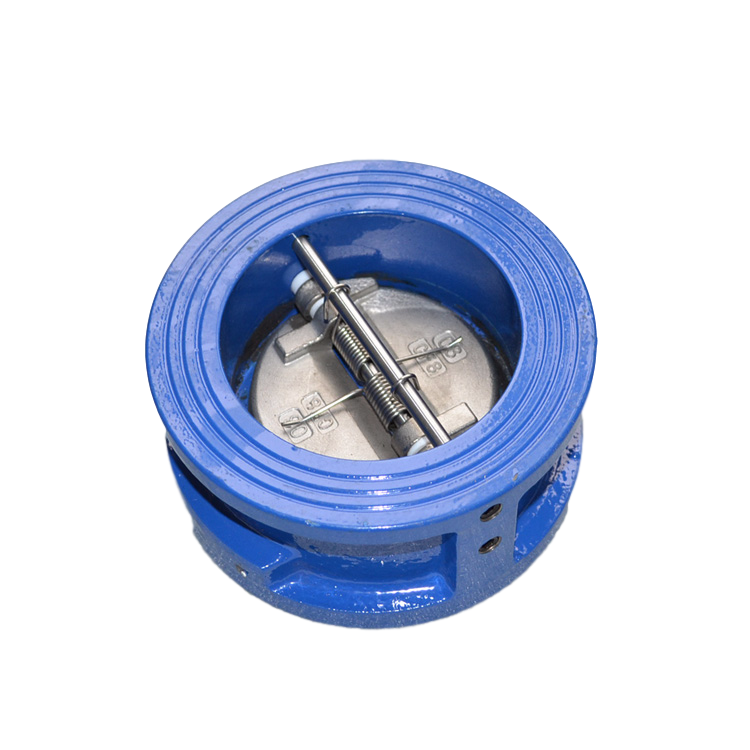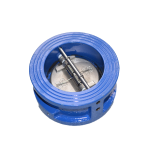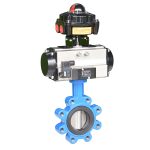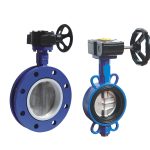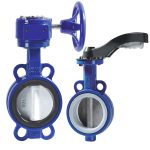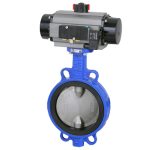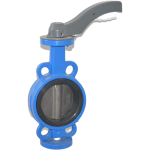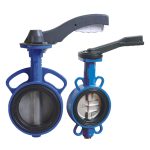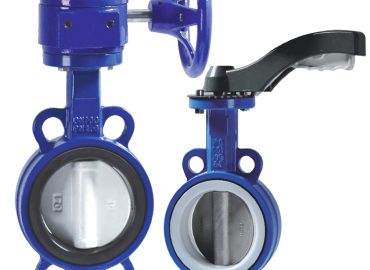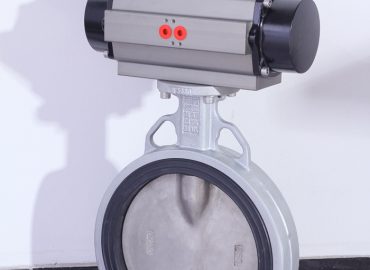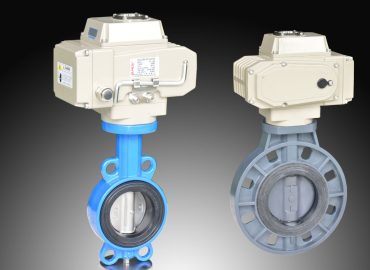In the world of fluid control systems, valves play an indispensable role. Among the various types of valves available, Wafer Check Valve and Swing Check Valve are two widely used ones, each with its unique set of characteristics and applications. However, choosing between the two can often be a challenging task for engineers and industry professionals. This blog post aims to provide a comprehensive comparative analysis of Wafer Check Valves and Swing Check Valve, delving into their design, operation, efficiency, cost implications, and more. By understanding these aspects, you will be better equipped to make informed decisions about which valve fits your specific needs. Let’s delve in and explore these two vital components of fluid control systems.
Introduction
In the realm of fluid control systems, Wafer Check Valve and Swing Check Valve are two crucial components that serve a similar purpose – to prevent backflow. However, they have distinct differences that make them suitable for varying applications. Starting with their design, Wafer Check Valve are compact, lightweight, and designed for systems where space is a premium. They fit between flanges in the pipe system, providing an efficient seal against backflow. Conversely, Swing Check Valve are more robust and heavier, featuring a disc that swings on a hinge or trunnion, which allows for greater flow area and lower pressure drop. When considering operational efficiency, Wafer Check Valve are known for their rapid response to changes in flow direction, thanks to their spring-assisted closure. This makes them highly effective in preventing backflow even in fast-flowing systems. Swing Check Valve, although slower in response due to their reliance on gravity and flow for closure, can handle a higher flow rate and are more tolerant of debris in the fluid. Cost-wise, the simpler construction and smaller size of Wafer Check Valve often make them less expensive initially. However, Swing Check Valve, with their durability and ability to handle a wider range of flow conditions, may offer better value in the long run. Ultimately, the choice between Wafer Check Valve and Swing Check Valve depends on your specific application needs, including factors such as space constraints, flow conditions, potential debris in the fluid, and cost considerations.
Brief explanation of what a valve is and its importance in fluid control systems.
A valve is a mechanical device that regulates, directs, or controls the flow of a fluid (such as gases, liquids, fluidized solids, or slurries) by opening, closing, or partially blocking various passageways. They are essential components in a vast array of applications, ranging from industrial processes to everyday household systems. In fluid control systems, valves are of paramount importance. They ensure that the fluid flows in the right direction at the desired rate, and also prevent backflow, which can cause system failure or damage. Moreover, they enable the safe and efficient operation of the system by maintaining pressure and temperature within acceptable limits. Valves also allow for isolation of parts of a system for maintenance or emergency situations without affecting the rest of the system. Therefore, the role of valves in fluid control systems is absolutely critical for safety, efficiency, and reliability.
Understanding Wafer Check Valve
Wafer Check Valves are a type of check valve that is designed to prevent the backflow of fluids in a piping system. They are named ‘wafer’ due to their thin, wafer-like design, which makes them compact and lightweight. This design allows for easy installation in tight spaces and systems where weight is a concern. Unlike other types of valves, they don’t need extra support, making them an ideal choice for large-scale industrial applications.
The primary function of a Wafer Check Valve is to allow fluid to flow in one direction and automatically close when the fluid attempts to flow back in the opposite direction. This is achieved through the use of a disc or plate that swings open when fluid flows forward and swings closed when the fluid attempts to flow backward. This simple yet effective mechanism ensures a smooth, uninterrupted flow of fluid or gas.
One of the key advantages of Wafer Check Valves is their speed. They respond quickly to changes in flow direction, making them suitable for systems with high flow rates. However, it’s important to note that they may not provide a complete seal, which can result in some degree of leakage.
In terms of cost, Wafer Check Valves are generally more affordable than other types of check valves due to their simple construction. They require less material to manufacture and are easier to install, leading to lower overall costs.
Despite their many advantages, Wafer Check Valves are not suitable for all applications. Due to their design, they might not be the best choice for systems with low flow rates or those that require a tight seal to prevent any backflow. In such cases, other types of check valves, like Swing Check Valves, might be more appropriate.
In conclusion, understanding Wafer Check Valve and their unique properties can help you make an informed decision when selecting the most suitable valve for your specific application.
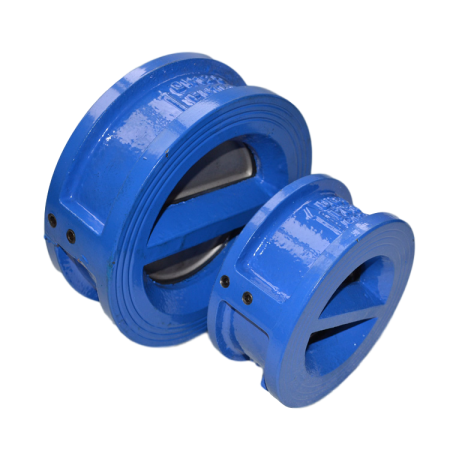
Definition of a wafer check valve.
A wafer check valve is a specific type of valve used in piping systems to regulate the flow of fluid or gas. Its primary function is to allow the substance to flow in one direction and prevent it from flowing backward. Named for its thin, wafer-like design, this valve is compact and lightweight, making it suitable for tight spaces and systems where weight is a concern. It operates through a disc or plate mechanism that swings open when the fluid flows forward and closes when the fluid attempts to flow backward. Despite its simplicity, it’s an efficient solution for high flow rate systems, although it may not provide a complete seal, resulting in potential leakage.
The principle of operation of wafer check valve.
The principle of operation of wafer check valves is centered around the concept of unidirectional fluid flow. When fluid or gas flows in the intended direction, it pushes against a disc or plate inside the valve, causing it to swing open and allow the substance to pass through. Conversely, when the fluid attempts to flow in the opposite direction, the pressure decrease causes the disc or plate to swing back to its original position, effectively closing the valve and preventing backflow. This automatic response to changes in flow direction is what makes wafer check valves an effective solution for maintaining consistent flow within a piping system. However, it’s important to note that while they are efficient in preventing backflow, they may not provide a completely tight seal, which can potentially lead to some degree of leakage.
The structure and components of a wafer check valve.
A wafer check valve is composed of several key components that work together to regulate fluid flow. The primary component is the disc or plate, which swings open or closed depending on the direction of the flow. This disc is typically made of a durable material like metal or plastic to withstand the pressure and potential corrosiveness of the fluids. Attached to the disc is a hinge, which allows the disc to swing back and forth. The disc and hinge are housed within the body of the valve, which is usually a circular or semi-circular shape. The body is thin and compact (hence the term ‘wafer’), making it suitable for installation in tight spaces. Finally, the valve may also include a spring mechanism to assist in closing the valve when the fluid tries to flow backward. Each of these components plays a crucial role in the operation of the valve, contributing to its effectiveness in preventing backflow and maintaining consistent fluid flow within a system.
Common applications of wafer check valve and why they are used in these areas.
Wafer check valves are commonly used in a variety of industries due to their compact design and efficient functionality. In the oil and gas industry, these valves are often used in pipelines to prevent the backward flow of substances, thereby ensuring a smooth and unidirectional flow. They are also prevalent in water treatment plants where they maintain the direction of water flow within the system. In the manufacturing sector, wafer check valves are used in machinery that requires fluid or gas to flow in one direction only. The food and beverage industry also utilizes these valves in their processing systems to prevent cross-contamination by ensuring that fluids don’t flow back into the source. The HVAC industry uses them to prevent reverse flow in air conditioning and heating systems. The primary reason for their widespread use is their ability to effectively prevent backflow in a compact design, making them suitable for systems where space and weight are concerns.
Understanding Swing Check Valve
Swing check valve, also known as non-return or one-way valves, are designed to allow fluid (liquid or gas) to flow through them in only one direction. The basic operational principle of these valves revolves around the swinging disc or flap that is the core part of its structure. When fluid flows in the intended direction, it pushes this disc open, allowing the fluid to pass through the valve. Once the fluid pressure decreases or tries to flow in reverse, the disc swings back to its original position due to gravity or a spring mechanism, effectively blocking the passage and preventing any backflow. This automatic response to changes in flow direction makes swing check valves a vital component in many piping systems.
The structure of a swing check valve typically includes a disc or flap, hinge pin, and body. The disc, connected to the hinge pin, swings like a door on its hinges. The body of the valve provides the enclosure within which the disc operates. Depending upon the design, there may be a single disc or multiple discs (in the case of a dual-plate swing check valve). The material of these components can vary based on the type of fluid the valve is intended for and the conditions of operation, such as pressure and temperature.
Swing check valves find widespread application across various industries due to their simple design and effective functionality. They are used extensively in water supply systems, sewage treatment plants, and oil and gas pipelines, among others. In these applications, their primary role is to prevent the reverse flow of fluids, thus ensuring system integrity and efficiency. They are especially useful in systems where backflow could cause damage or pose a safety risk. However, it’s important to note that swing check valves require enough velocity from the fluid flow to open fully and function properly. Therefore, they may not be suitable for systems with low flow rates. Despite this, their ability to prevent backflow with minimal pressure loss makes them an invaluable tool in fluid control systems.
Definition of a swing check valve.
A swing check valve, also known as a non-return or one-way valve, is a type of valve designed to allow fluid (either gas or liquid) to flow in only one direction. Its primary function is to prevent backflow in a system. The valve operates automatically, with the flow of the fluid determining its open or closed state. The main components of a swing check valve include a disc or door and a hinge. When fluid flows in the intended direction, it pushes against the disc, causing it to swing open around the hinge, thus allowing the fluid to pass through. Conversely, when the fluid tries to flow in the opposite direction, the disc swings back to its original position, effectively blocking the passage and preventing backflow. This simple yet effective mechanism makes swing check valves an essential component in various fluid control systems across many industries.
The principle of operation of swing check valve.
The principle of operation of swing check valves is based on the directional flow of fluid. These valves are designed to allow fluid (either gas or liquid) to flow in only one direction, thereby preventing backflow. The core mechanism involves a swinging disc or door that’s attached to a hinge. When fluid flows in the designated forward direction, it exerts pressure on the disc, causing it to swing open around the hinge. This opens up the passageway for the fluid to flow through the valve. However, when the fluid attempts to flow back in the opposite direction, the decrease in pressure allows the disc to swing back and close off the passage due to gravity or a spring mechanism. This effectively blocks the fluid from flowing backward. It’s important to note that for a swing check valve to function correctly, the fluid must have sufficient velocity to fully open the valve. This automatic response to changes in fluid flow direction makes swing check valves a crucial component in many piping systems.
The structure and components of a swing check valve.
A swing check valve is composed of several key components that allow it to effectively control the flow of fluid. The primary component is the disc or door, which is the part that opens and closes to permit or prevent fluid flow. This disc is attached to a hinge, which enables the swinging motion. When fluid pressure pushes against the disc in the right direction, it swings open around the hinge, allowing fluid to pass through. Conversely, when the fluid tries to flow back, the disc swings closed, blocking the passage. The body of the valve provides the enclosure within which the disc operates. Depending on the design and application, a swing check valve could have a single disc or multiple discs, as seen in dual-plate swing check valves. The materials used for these components can vary widely, depending on the type of fluid the valve is designed to handle and the operating conditions such as pressure and temperature. Other elements, like springs or weights, may also be incorporated to assist in closing the disc when fluid flow decreases or reverses.
Common applications of swing check valve and why they are used in these areas.
Swing check valves are commonly used in a variety of industries due to their ability to prevent backflow in fluid systems. In the water and wastewater industry, they’re often used in pumping systems where it’s crucial to prevent the reverse flow of water, which could cause harmful pressure surges or damage equipment. They’re also frequently used in the oil and gas industry for similar reasons, as preventing backflow is critical in pipelines carrying crude oil, natural gas, or refined products. The chemical industry uses swing check valves to control the flow of various corrosive or hazardous substances, ensuring they only move in the intended direction. Furthermore, in power generation plants, particularly those using steam, swing check valves play a vital role in boiler feed lines and other high-pressure applications. Their simple yet effective design, coupled with their automatic operation and ability to handle a wide range of pressures and temperatures, makes swing check valves an essential component in these and many other applications.
Comparative Analysis of Wafer Check Valve Vs. Swing Check Valve
Wafer check valves and swing check valves are two types of check valves that serve similar functions of preventing backflow in fluid systems, but they differ significantly in design and application. The primary difference between them lies in their body design. Swing check valves are typically more substantial and require more space for installation compared to wafer check valves, which are designed for tight spaces. This makes wafer check valves ideal for applications where space is limited. However, swing check valves are often preferred in applications involving gas and liquid systems, flood prevention systems, sewage, and toilets due to their reliability and robustness. Furthermore, it’s important to note that swing check valves can have a higher slamming effect, which refers to the sudden stoppage of reverse flow, potentially causing water hammer or system shocks. On the other hand, dual plate check valves, a type of wafer check valve, are more popular as they tend to have less of a slamming effect. The choice between these two types of valves often depends on the specific requirements of the application, including space constraints, the nature of the fluid being handled, the operating pressure and temperature, and the potential impact of valve slamming. It’s crucial to carefully consider these factors to select the most appropriate valve for each unique situation.
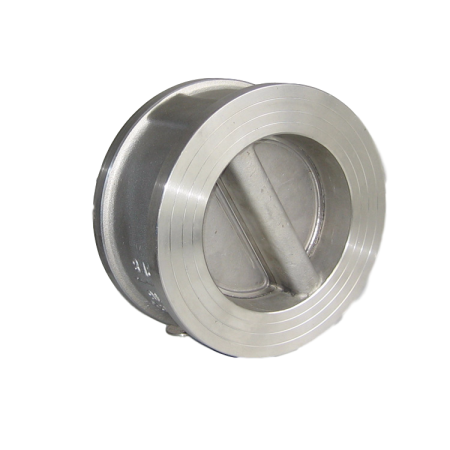
Comparison of design and structure.
When comparing the design and structure of wafer check valves and swing check valves, several differences become apparent. Swing check valves typically have a more robust structure, with a disc or door that swings on a hinge to allow or block fluid flow. This design is generally larger and requires more space for installation. On the other hand, wafer check valves have a more compact design, featuring a spring-assisted disc that moves vertically to control fluid flow. This design is much smaller, requiring less space for installation, making it ideal for tight spaces or systems with limited room. However, while wafer check valves offer the advantage of space efficiency, they often have lower flow coefficients compared to swing check valves, meaning they may not be as efficient in allowing fluid flow. Therefore, the choice between these two types of valves often depends on the specific requirements of the application, including space constraints and desired flow efficiency.
Comparison of operational efficiency.
Operational efficiency differs significantly between swing check valves and wafer check valves. Swing check valves are typically more efficient at allowing fluid flow due to their larger disc design which provides a full port when open, resulting in lower pressure drop across the valve. This makes them ideal for applications requiring high flow rates and efficiency. However, the swinging motion of the disc can lead to a higher slamming effect when the flow is reversed, potentially causing water hammer or system shocks. Conversely, wafer check valves, particularly the dual plate type, are designed to minimize the slamming effect, which can enhance the overall operational efficiency by reducing potential damage to the system. Nevertheless, due to their smaller, compact design, wafer check valves often have lower flow coefficients, meaning they may not be as efficient in allowing fluid flow compared to swing check valves. Therefore, the choice between these two types of valves often depends on the specific requirements of the operation, including desired flow efficiency and the need to minimize potential system shocks.
Comparison of installation and maintenance needs.
The installation and maintenance needs of wafer check valves and swing check valves are quite different due to their distinct designs. Swing check valves, with their larger and more robust structure, require a significant amount of space for installation. They also often need to be installed in a specific orientation, typically in a horizontal pipeline, to function correctly. However, they are generally easier to maintain because their design allows for easy access to internal parts. On the other hand, wafer check valves have a more compact design that requires less space for installation, making them ideal for tight spaces or systems with limited room. They can also be installed in any orientation – horizontal, vertical, or angled – providing greater flexibility. But their maintenance can be more challenging due to their compact design, which can make it harder to access internal parts for repair or replacement. Therefore, when choosing between these two types of valves, considerations should include available space for installation, desired installation orientation, and maintenance requirements.
Comparison of cost implications – initial cost, maintenance cost, potential savings.
When comparing the cost implications of swing check valves and wafer check valves, one must consider both the initial cost and the ongoing maintenance costs, as well as potential savings from operational efficiency. Swing check valves, due to their larger and more robust design, are generally more expensive initially than wafer check valves. They also may incur higher installation costs due to the need for more space and specific orientation. However, their maintenance costs can be lower since their design allows for easy access to internal parts, reducing labor costs for repairs or replacements. In contrast, wafer check valves, with their compact design, are typically less expensive initially and require less space for installation, potentially saving on initial setup costs. But they may have higher maintenance costs due to the difficulty in accessing internal parts for servicing. Furthermore, if a wafer check valve’s ability to minimize system shocks leads to fewer breakdowns and longer system life, it could result in significant long-term savings. Thus, the total cost of ownership can vary depending on these factors, and it’s essential to consider both short-term and long-term costs when choosing between these two types of valves.
Comparison of common applications and their effectiveness.
Swing check valves and wafer check valves each have their own common applications where they are most effective. Swing check valves, with their full port design and lower pressure drop, are often used in applications requiring high flow rates such as water distribution systems, wastewater treatment plants, and industrial process piping systems. The efficiency of these valves in allowing fluid flow makes them highly effective in these settings. However, their susceptibility to system shocks or water hammer can be a disadvantage in systems with rapid flow reversals. On the other hand, wafer check valves, particularly dual plate types, are commonly used in systems where space is limited and where it’s crucial to minimize the potential for system shocks, such as HVAC systems, and oil and gas pipelines. Their compact design and ability to minimize system shocks make them effective in these applications. However, their lower flow coefficient may make them less efficient in systems requiring high flow rates. Therefore, the effectiveness of these valves largely depends on the specific requirements of the application.
Pros and Cons of Wafer Check Valve and Swing Check Valve
Wafer check valves and swing check valves both have their unique advantages and disadvantages, which make them suitable for different applications. Starting with wafer check valves, their biggest advantage lies in their compact design. They are much smaller and lighter than most other types of check valves, making them ideal for use in tight spaces or systems where weight is a consideration. They can be installed in any orientation – horizontal, vertical, or angled – providing greater flexibility. Additionally, their design helps to minimize the potential for system shocks or water hammer, which can be a significant benefit in systems with rapid flow reversals. However, there are also drawbacks to wafer check valves. Their compact design can make maintenance more challenging, as it can be harder to access internal parts for repair or replacement. Also, they generally have a lower flow coefficient than swing check valves, which means they may not be as efficient in systems requiring high flow rates.
On the other hand, swing check valves have their own set of pros and cons. One of their biggest advantages is their full port design, which allows for higher flow rates and lower pressure drop. This makes them suitable for applications requiring high flow efficiency, such as water distribution systems or industrial process piping systems. Furthermore, they are generally easier to maintain than wafer check valves because their design allows for easy access to internal parts. However, swing check valves also have their drawbacks. They require a significant amount of space for installation and need to be installed in a specific orientation, typically in a horizontal pipeline, which can limit their applicability. Moreover, they are more susceptible to system shocks or water hammer than wafer check valves, which can potentially lead to damage and system downtime. Therefore, when choosing between these two types of valves, it’s essential to consider the specific requirements of the application, including space constraints, flow requirements, potential for system shocks, and maintenance needs.
Advantages and disadvantages of wafer check valve.
Wafer check valves come with a range of advantages that make them suitable for various applications. Their compact and lightweight design is one of their primary benefits, making them an excellent choice for systems where space is limited or weight is a crucial factor. They can be installed in any orientation – horizontal, vertical, or angled, offering greater flexibility. Furthermore, wafer check valves are designed to minimize the potential for system shocks, also known as water hammer, which can be beneficial in systems with rapid flow reversals. However, these valves are not without their disadvantages. The compact design that makes them so versatile can also cause maintenance challenges, as it may be harder to access internal parts for repair or replacement. Additionally, they generally have a lower flow coefficient compared to other types of check valves like swing check valves. This means they might not be as efficient in systems requiring high flow rates. Therefore, while wafer check valves are a practical solution in many scenarios, their suitability should be assessed concerning the specific requirements of each application.
Advantages and disadvantages of swing check valve.
Swing check valves have several key advantages that make them attractive for a range of applications. They are known for their full port design, which allows for high flow rates and lower pressure drop. This makes them a suitable choice for applications that require high flow efficiency such as water distribution systems or industrial process piping systems. In terms of maintenance, swing check valves tend to be easier to maintain than some other types of valves because their design allows for straightforward access to internal parts. However, there are also disadvantages associated with swing check valves. One significant drawback is that they require a substantial amount of space for installation, which can limit their use in compact systems. They also need to be installed in a specific orientation, typically in a horizontal pipeline, reducing their flexibility compared to other valve types. Additionally, swing check valves are more susceptible to system shocks, or water hammer than some other types of valves, which can potentially lead to damage and system downtime. As such, the suitability of swing check valves should be evaluated based on the specific needs and constraints of each application.
Choosing Between Wafer Check Valve and Swing Check Valve
Choosing between wafer check valves and swing check valves requires a careful evaluation of the specific requirements of your application. Wafer check valves are typically smaller, lighter, and more compact, making them an excellent choice for tight spaces or systems where weight is a critical consideration. They can be installed in any orientation – horizontal, vertical, or angled – providing greater flexibility. These valves are also designed to minimize system shocks, or water hammer, making them a good fit for systems with rapid flow reversals. However, their compact design can make maintenance more challenging, as it can be harder to access internal parts for repair or replacement. Plus, they generally have a lower flow coefficient than swing check valves, which means they may not be as efficient in systems requiring high flow rates.
On the other hand, swing check valves have a full port design that allows for higher flow rates and lower pressure drop. This makes them well-suited for applications requiring high flow efficiency, such as water distribution systems or industrial process piping systems. Swing check valves are generally easier to maintain than wafer check valves due to their design, which allows for easy access to internal parts. However, they do require more space for installation and need to be installed in a specific orientation, typically a horizontal pipeline. Also, they are more susceptible to system shocks or water hammer than wafer check valves, which could potentially lead to damage and system downtime.
In conclusion, both types of valves have their unique strengths and weaknesses. The choice between wafer check valves and swing check valves should be based on the specific needs of your application, including space constraints, flow requirements, potential for system shocks, and maintenance needs.
Factors to consider when choosing between the two types of valves.
When choosing between wafer check valves and swing check valves, several factors need to be taken into account. The first is the space available for installation. Wafer check valves, being compact, are more suitable for systems with limited space, while swing check valves require more room. The flow requirements of your system are also crucial; swing check valves are more efficient for high flow rates due to their full port design, while wafer check valves have a lower flow coefficient. The potential for water hammer or system shocks is another consideration – wafer check valves are designed to minimize this risk, unlike swing check valves. Maintenance needs should also be factored in; swing check valves typically allow for easier access to internal parts, making them potentially less challenging to maintain than wafer check valves. Finally, the orientation of installation may influence your decision, as swing check valves need to be installed in a specific orientation, typically horizontal, while wafer check valves offer greater flexibility. Evaluating these factors in light of your system’s specific needs will help you make an informed decision.
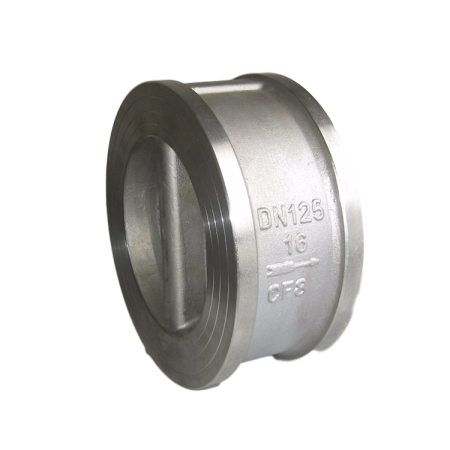
Situational analysis providing scenarios where one might be preferable over the other.
Situational analysis can be extremely helpful in determining whether a wafer check valve or a swing check valve might be more suitable for a particular application. For instance, consider a scenario where you are designing a compact water treatment system with limited space. The compact design of the wafer check valve would likely make it more desirable in this case. Furthermore, if the system is vertically oriented or has an angle, the ability to install wafer check valve in any orientation becomes a significant advantage.
On the other hand, suppose you’re working on a large-scale industrial process that requires high flow rates and easy maintenance. In this situation, a swing check valve, with its full port design allowing higher flow rates and straightforward access to internal parts, would probably be the better choice. Moreover, if the system is primarily horizontal, the orientation requirement of the swing check valve poses no issue.
Lastly, consider the scenario of a system prone to rapid flow reversals, which could cause system shocks or water hammer. Here, the wafer check valve’s design, which minimizes these risks, could make it the preferable option. These examples illustrate how the specific characteristics and requirements of each situation can guide the selection between wafer check valve and swing check valve.
Conclusion
In conclusion, the decision between wafer check valve and swing check valve is not a one-size-fits-all solution but rather a careful consideration of the specific requirements and constraints of your application. Both types of valves have their unique strengths and potential drawbacks.
Wafer check valve, with their compact design, are an excellent choice for systems with space limitations or where weight is a critical factor. Their ability to be installed in any orientation offers flexibility that can be invaluable in complex or unconventional systems. Additionally, their design minimizes the risk of system shocks or water hammer, making them suitable for systems prone to rapid flow reversals.
On the other hand, swing check valve, with their full port design, shine in applications requiring high flow rates. They are typically easier to maintain due to their design, which allows for easy access to internal parts. Despite needing more room for installation and a specific orientation, typically horizontal, their efficiency in high flow systems can outweigh these considerations.
A thorough analysis of your system’s needs is crucial when choosing between these two types of valves. Factors such as available space, flow requirements, potential for water hammer, and maintenance needs should all be carefully evaluated. By doing so, you can ensure that you select the valve that best suits your system’s requirements, thereby optimizing performance and reliability.
Remember, the goal is not simply to choose a valve but to select the valve that will most effectively contribute to the overall success of your system. Whether it’s a wafer check valve or a swing check valve, the right choice can make a significant difference in the efficiency, maintenance, and longevity of your system. Always consider your unique situational needs, consult with experts if needed, and make an informed decision that will ensure the smooth operation of your application.


